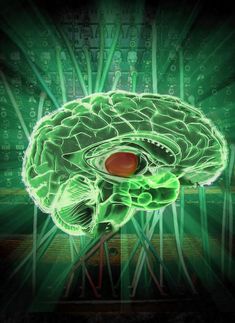New biosensors reveal workings of anti-psychotic drugs in the living brain
Scientists have resolved a question about how a popular class of drugs used to treat schizophrenia works using biosensors that reveal previously hidden components of chemical communication in the brain. Although delusions and hallucinations characterize the illness, people with schizophrenia also struggle to sustain attention or recall information in a particular order, difficulties that interfere with their ability to hold a job or function well, said Lee Schroeder, a student in the medical scientist training program at the University of California, San Diego.
A class of drugs called atypical neuroleptics has become the most commonly prescribed treatment for schizophrenia, in part for their ability to improve these cognitive functions. How they altered brain chemistry was uncertain, however. Atypical neuroleptics elicit large releases of the neurotransmitter acetylcholine. But they had also been shown to barricade a particular type of receptor on the receiving cell's surface, which would block the message.
The question was, which action prevails? The answer might guide the development of more effective drugs with fewer side effects. "The hunt is now on," said Schroeder, who shares lead authorship on the paper. "What about these drugs helps? That's where our cells come in."
To find out, the team designed biological cells that change color when acetylcholine latches onto this particular class of receptors, called M1. That allowed them to see when M1 receptors received the chemical message, an event neuroscientists had previously been unable to detect in a living, intact brain. "It's a world of signaling between cells that we were blind to before," said David Kleinfeld, professor of physics and member of UC San Diego's center for neural circuits and behavior, who led the collaboration that invented the system.
The team implanted the cells, which they call CNiFERs (pronounced "sniffers"), in rat brains, then stimulated a deeper part of the brain in a way known to release acetylcholine nearby. They saw a color change, evidence that the CNiFERs were working. Then they gave the rats one of two atypical neuroleptics. In both cases, the drug severely depressed the response, indicating that the drugs' receptor-blocking action overrides the increase in acetylcholine they report in Nature Neuroscience.
CNiFERs could be re-designed to detect the activity of other types of receptors as well, work that is underway. "The technique puts CNiFERs together from easily obtained molecular components," said Quoc-Thang Nguyen, a former research associate in Kleinfeld's lab who shares lead authorship with Schroeder. Nguyen recently founded Femtoscience, a company that has licensed the technology from UC San Diego and will develop it as a way to screen drugs.
Most read news
Organizations
Other news from the department science
These products might interest you

Octet R2 / Octet R4 / Octet R8 by Sartorius
Full power on 2, 4 or 8 channels: Label-free and GxP-compliant analysis of molecular interactions
Innovative label-free real-time protein quantification, binding kinetics and rapid screenings

Octet RH16 and RH96 by Sartorius
Efficient protein analysis for process optimisation and manufacturing control in high-throughput
Label-free protein quantification and characterization of protein-protein interactions

Octet SF3 by Sartorius
Surface Plasmon Resonance (SPR) using Single Dynamic Injections for Kinetics and Affinities
Curvature is Key - Adding a ‘Third Dimension’ to the Binding Curve

Get the life science industry in your inbox
By submitting this form you agree that LUMITOS AG will send you the newsletter(s) selected above by email. Your data will not be passed on to third parties. Your data will be stored and processed in accordance with our data protection regulations. LUMITOS may contact you by email for the purpose of advertising or market and opinion surveys. You can revoke your consent at any time without giving reasons to LUMITOS AG, Ernst-Augustin-Str. 2, 12489 Berlin, Germany or by e-mail at revoke@lumitos.com with effect for the future. In addition, each email contains a link to unsubscribe from the corresponding newsletter.





















































